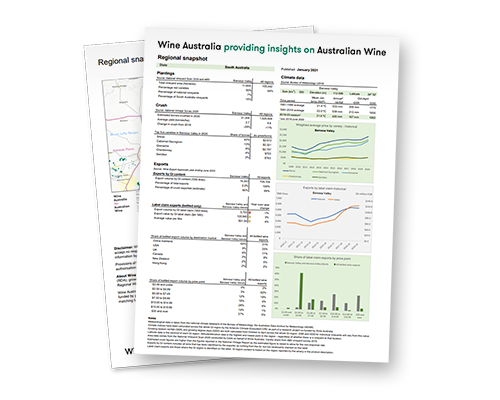Evolution of an Australian classic
Chardonnay is the fifth most planted winegrape variety in the world, after Cabernet Sauvignon, Merlot, Tempranillo and Airen. Chardonnay has been described by Jancis Robinson as ‘the most famous vine variety of all’ because it has almost no synonyms and therefore its name is widely recognised worldwide.
Australia has approximately 10 per cent of the world’s Chardonnay plantings and is the third largest grower of the variety after France and the USA.
Chardonnay is Australia’s most widely planted white variety and is second only to Shiraz overall. The crush of Chardonnay in Australia has grown from 1000 tonnes in 1979 to a peak of 428,000 tonnes in 2008.

Chardonnay Variety Snapshot 2024-25
Variety snapshots are one-page profiles of individual Australian winegrape varieties and provide at-a-glance summary statistics on: viticulture data, winegrape production, winegrape price, key producing regions and export sales data compared against the same statistics for all wine grape varieties.
Download nowIn the vineyard
Chardonnay is an adaptable variety and can be grown in cool regions as well as warm areas. It is a productive, early budding and early ripening variety.
It is a thin-skinned variety, which makes it susceptible to botrytis bunch rot.



In the winery

- Extremely flexible with regard to various winemaking techniques
- Oak fermentation and maturation is common for top quality wines
- Attitudes toward malolactic fermentation are evolving – full versus partial versus none
- Overall shift toward less intervention

- Less new oak and use of larger format barrels for more subtle and complex wines
- Unoaked Chardonnays tend to be fresh and vibrant styles for early drinking
- Extended lees contact during maturation is common, adding complexity and texture
Major regional expressions
Adelaide Hills
- The undulating and sometimes very steep aspects combined with average altitudes over 400 metres means that Adelaide Hills is the coolest region in South Australia
- This region is ideally suited to the production of complex Chardonnay
- The wines are typically complex and textured with peach and citrus flavours
Margaret River
- Margaret River has established itself as one of Australia’s premier Chardonnay producing regions
- The warm climate is tempered by the effects of the Indian and Southern Oceans
- The style is typically concentrated, rich and complex with typical lime-like acidity
Mornington Peninsula
- The cooling effects of the ocean are felt throughout the Mornington Peninsula
- The cool climate is ideal for the production of pure-fruited, restrained Chardonnay
- Creates medium-weight wines with delicate flavours of melon, white peach and citrus
Yarra Valley
- The Yarra Valley has a diverse array of micro climates and vineyard aspects which impacts Chardonnay’s style
- Elevated vineyards sites allow for a restrained and subtle style
- Diverse characteristics but typically medium-bodied, textured wines with signature flavours of white peach
In the glass
Style and character
Pairs with
Chicken, pork and white fish dishes, prawns, lobster and crab.
